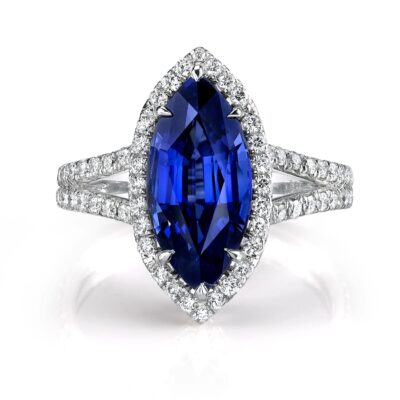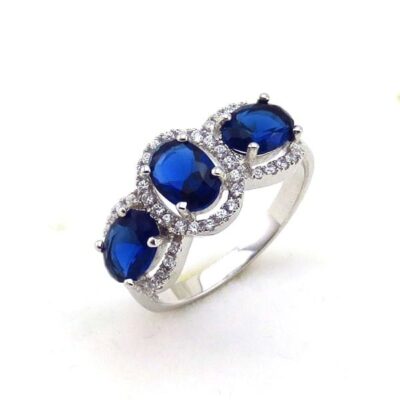Sapphire Engagement Rings
Over the last few years, we’ve seen a clear rise in the number of clients choosing sapphire engagement rings, a trend which started even before Prince William proposed to Duchess of Cambridge with a sapphire ring.

Formed from a mineral called corundum, sapphire is a very hard gemstone (only diamond is harder), scoring 9 on the Mohs scale. This makes it well suited to withstanding the wear and tear that engagement rings are subjected to. Part of its popularity might also be explained by the fact that sapphires tend to be priced attractively compared to the other major engagement ring gemstones — diamonds, emeralds and rubies. Unlike diamonds, it is relatively unusual for sapphires to be certified. Even certified sapphires are not graded against universally accepted criteria for colour, clarity and cut in the way that diamonds are.
Bigger Isn’t Always Better

Like all gemstones, the size of a sapphire is expressed in terms of its carat weight, with 1 carat equal to 0.2 grams. It’s worth bearing in mind that sapphire is more dense than diamond, so a sapphire will be smaller than a diamond of the same weight.It’s not always the case that ‘bigger equals better’, as a really large sapphire could be impractical for an engagement ring that is going to be warn on a daily basis. Cost is also a consideration, as the value of a sapphire will tend to increase exponentially with size. In other words, if you double the size of a sapphire then the value of the stone will more than double.
Blue Isn’t The Only Colour
Most sapphires are blue, but they also come in a range of pinks, yellows, purples, oranges and greens. Many clients prefer a rich royal blue or peacock blue shade, that looks good under various light sources. In bright daylight really pale stones can look ‘washed out’, while very dark sapphires tend to perform less well under weaker light. It’s also important to consider the colour’s hue – some clients like a hint of violet behind the dominant blue.
Look Out For Zoning
It is not unusual for the colour of a sapphire to be unevenly distributed within a stone, creating patches of light and dark. This is known as zoning, and can give sapphires a slightly stripy appearance, as shown in the stone on the left. Often sapphires are cut so that any zoning is not visible when the stone is viewed from above, which means that with an appropriate setting (such as a rub-over setting) the zoning will be invisible in the finished jewellery.
Most Sapphires Have Some Inclusions
Sapphires are defined as ‘Type 2’ gemstones by the Gemological Institute of America (GIA). This means it’s very rare to find sapphires that are entirely free of natural blemishes or ‘inclusions’. For most clients the important thing is how the stone looks to their naked eye, and if a sapphire has one or two very small inclusions this is often considered acceptable.
If you’re looking for a flawless sapphire, just be aware that these can be extremely expensive!
Ovals And Cushions Offer Best Value
A gem cutter’s job is to maintain as much weight as possible, while also achieving the best possible colour and pleasing proportions. The facets should be sharply defined, with a smooth finish. Sapphires can often be left quite deep relative to their total weight. It’s worth taking time to check how well a sapphire has been finished, as not all cutters are equally skillful or careful. Most rough sapphire crystals have an elongated shape, which means that cutting to oval or rectangular cushion shapes will tend to preserve the most weight. As a result, there is normally a good selection of top-quality stones to choose from in these shapes. While it is possible to source other shapes, there is less choice, and they tend to trade at a premium.
Look Out For Undisclosed Treatment
Unless a supplier tells you otherwise, you should assume that a sapphire has experienced heat enhancement. This technique is so common and so well-established within the industry that it’s not generally thought necessary to disclose it. This is a centuries-old process to improve the colour and clarity of a sapphire, and leaves it in a stable state that won’t alter over time. A few sapphires are naturally so good that the supplier will decide not to have them heated. Often these stones will be sent to a laboratory for certification, and will be supplied with paperwork to confirm ‘no evidence of thermal enhancement’.
As you might expect, certified unheated sapphires tend to trade at a significant premium. There are two treatments in particular that you ought to be wary of. The first is diffusion, which involves heating sapphires alongside materials like titanium or beryllium, which diffuse into the crystal. The result is a layer of strong colour near the surface, which doesn’t permeate all the way through the stone. Subsequent chipping or re-cutting will reveal the true colour within. The second is fracture filling, where inclusions are filled with resin or lead-glass to improve a sapphire’s clarity. At first glance the stone might appear better looking, but the more this is done, the weaker the stone becomes.Fracture-filled and diffused sapphires are not valuable, and should never be sold without full disclosure of these treatments. If you are in any doubt, you should ask to have a sapphire examined by an independent gemologist before making a decision.
Ethical Sapphires
At A Star Diamonds , we source only sapphires that have been produced in a socially and environmentally responsible way, and which we can trace back to mine of origin. The only treatment we accept is heating, and we also offer unheated sapphires.In the gallery below, you can view the selection of sapphire engagement rings that we have available in our collection. We’d also be delighted to design and make a bespoke ring to your specifications and set with the sapphire of your choice.
Please feel free to get in touch if you have any questions, or to discuss commissioning your own bespoke design.